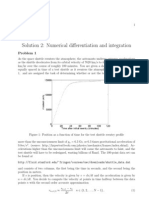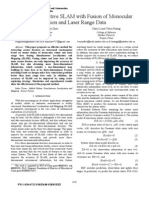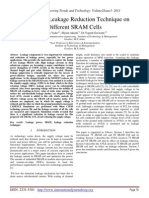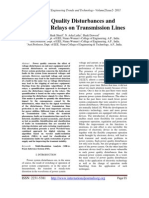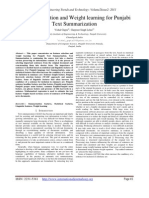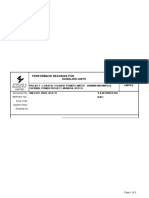Extended Linearization Technique: GPS User Position Using
Extended Linearization Technique: GPS User Position Using
Uploaded by
surendiran123Copyright:
Available Formats
Extended Linearization Technique: GPS User Position Using
Extended Linearization Technique: GPS User Position Using
Uploaded by
surendiran123Original Title
Copyright
Available Formats
Share this document
Did you find this document useful?
Is this content inappropriate?
Copyright:
Available Formats
Extended Linearization Technique: GPS User Position Using
Extended Linearization Technique: GPS User Position Using
Uploaded by
surendiran123Copyright:
Available Formats
International J ournal of Engineering Trends and Technology- Volume2Issue2- 2011
ISSN: 2231-5381 http://www.internationaljournalssrg.org Page 34
GPS User Position Using
Extended Linearization Technique
B.Hari Kumar
#1
, Dr. Dixit
#2
, N.Namassivaya
#3
, G.V.Chalapathi Rao
#4
Professor & Head, ECE Department, M.V.S.R.Engineering College, Hyderabad, A.P., India.
Professor, ECE Department, Allahabad University, Allahabad, U.P., India
Associate Professor, ECE Department, M.V.S.R.Engineering College, Hyderabad, A.P., India
Assistant Professor, ECE Department, M.V.S.R.Engineering College, Hyderabad, A.P., India
Abstract - The position of a GPS receiver can be determined by
obtaining pseudoranges from a minimum of four different GPS
satellites. The measured ranges do not represent the true ranges as
the signal coming from a GPS satellite will be contaminated by
various errors like Ephemeris error; Propagation error in the form
of I onospheric and Tropospheric delays; Satellite and Receiver
clock biases with respect to GPS Time (GPST); Multipath error
etc. Most of these errors can be estimated accurately and can be
accounted for. After making necessary corrections to the observed
pseudoranges the receiver position in ECEF coordinates (x
u,
y
u
, z
u
)
and the receiver clock bias with GPS Time (GPST) t
u
can be
determined either by using Linearization Technique [1] or Method
of least squares using Bancroft Algorithm [2]. As it is easy to
implement, most of the GPS receivers employ former method for
fixing the user position when a great degree of accuracy is not
required. The latter method is found to be more accurate when
pseudoranges from more than four satellites are considered [3]. So
far only Bancroft method has been suggested for an accurate
estimation of a GPS receiver position when more than four
satellites are observed. I n this paper we are proposing a new
technique namely, Extended Linearization Technique (ELT) for
the estimation of an user position. Results show that the accuracy
obtained using ELT is better compared to the Linearization
Technique and is on par with the Bancroft algorithm for over
specified cases when pseudoranges from more than four satellites
are observed. GPS data of Chitrakut station in RI NEX format has
been used for this purpose.
Keywords - Earth Centered Earth Fixed (ECEF), Global
Positioning System (GPS), GPS Time (GPST), Receiver
I ndependent Exchange (RI NEX).
I. INTRODUCTION
The Global Positioning System is all weather, space based
navigation system. It is a constellation of a minimum of 24
satellites in near circular orbits, positioned at an approximate
height of 20,150 km. above the earth. The satellites travel with a
velocity of 3.9 km/sec with an orbital period of 11 hours 58
minutes. The satellites transmit C/A (Coarse/Acquisition) and
P (Precision) codes, Navigation message, Clock parameters etc.
at two frequencies namely L
1
(1575.42 MHz) and
L
2
(1227.60 MHz). These signals can be received and processed
to obtain the user position in 3-D (latitude, longitude and
altitude), velocity and time accurately.
The user estimates an apparent or pseudorange to each SV
(Satellite Vehicle) by measuring the transit time of the signal.
The measured ranges do not represent the true ranges as the
signal coming from a GPS satellite will be contaminated by
International J ournal of Engineering Trends and Technology- Volume2Issue2- 2011
ISSN: 2231-5381 http://www.internationaljournalssrg.org Page 35
various errors. Most of these errors can be estimated accurately
and can be accounted for. After making necessary corrections to
the observed pseudoranges the receiver position in ECEF
coordinates (x
u,
y
u
, z
u
) and the receiver clock bias with GPS
Time (GPST) t
u
can then be determined. If the unknown
coordinates of the user position are represented by x
u
, y
u
and
z
u
and the known positions of Satellite Vehicles are with x
j
, y
j
,
z
j,
(
where j =1,2,3,4) in ECEF coordinate system, the user
position (in 3-D) and time offset t
u
are obtained by
simultaneously solving the nonlinear equations given below.
( ) ( ) ( )
u
2
u j
2
u j
2
u j j
ct z z y y x x + + + = ;
j =1,2,3,4. (1)
Where c is the free space velocity of electromagnetic wave in
m/s.
The measured ranges do not represent true ranges as the signal
coming from a satellite is affected by various errors like
ephemeris error, propagation error in the form of ionospheric
and tropospheric delays, satellite and receiver clock biases with
respect to GPST, multipath error etc. In order to determine the
receiver position accurately, all these errors have to be estimated
and compensated for. In this paper, the ionospheric delay is
estimated using Klobuchar model [4]. Hopfield model has been
used for the estimation of tropospheric delay [5]. Satellite
clock bias and the relativistic effects also have been estimated
and accounted for. Finally the user position is estimated using
the Linearization technique, Method of least squares using
Bancroft algorithm and also by the proposed Linearization
Technique. The results show that ELT is more accurate in
determining the user position than the linearization method and
is comparable to Bancroft algorithm.
II. EXTENDED LINEARIZATION TECHNIQUE (ELT)
If more than four GPS satellites are observed at a given epoch
time, using this proposed Extended Linearization Technique a
better accuracy can be obtained. Where as the Linearization
technique makes use of only four observables at a given epoch
time, this proposed technique makes use of all the observations
thereby accuracy in determining the position of a GPS user is
improved. To determine the user position in three dimensions
(x
u
, y
u
, z
u
) and the receiver clock offset t
u
, pseudoranges are to
be obtained from a minimum of four satellites.
( ) ( ) ( )
u
2
u j
2
u j
2
u j j
ct z z y y x x + + + = ;
j = 1,2,3,m. (2)
Where m is the number of satellites observed.
The resulting equations can be written as a function of user
coordinates and clock offset as
( )
u u u u j
t z y x f , , , = (3)
Using an approximate position location ) z , y , x (
u u u
and time
bias estimate
u
t
, an approximate pseudorange can be calculated
( ) ( ) ( )
u u j u j u j j
t c z z y y x x
2 2 2
+ + + = ;
j =1, 2, 3, -------, m (4)
=f )
u u u u
t , z , y , x (
The unknown user position and receiver clock offset are
considered to consist of an approximate component and an
incremental component as stated below.
u u u
x x x A + =
u u u
y y y A + =
u u u
z z z A + =
u u u
t t t A + =
This allows writing Eq. (3) as
( ) ( )
u u u u u u u u u u u u
t t z z y y x x f t z y x f A + A + A + A + =
, , , , , , (5)
This latter function can be expanded about the approximate
point using a Taylor series. It can be shown that
u u
j
u j
u
j
u j
u
j
u j
j j
t c z
r
z z
y
r
y y
x
r
x x
A A
+ A
+ A
(6)
International J ournal of Engineering Trends and Technology- Volume2Issue2- 2011
ISSN: 2231-5381 http://www.internationaljournalssrg.org Page 36
Where ( ) ( ) ( )
2 2 2
u j u j u j j
z z y y x x r + + =
j j j
= A (7)
j
u j
zj
j
u j
yj
j
u j
xj
r
z z
a
r
y y
a
r
x x
a
= (8)
Where a
xj
, a
yj
and a
zj
terms denote the direction cosines of the
unit vector pointing from the approximate user position to the j
th
satellite.
Rewriting Equation (6) results into
u u zj u yj u xj j
t c z a y a x a A A + A + A = A (9)
When pseudorange measurements are made to m satellites
(j =m), Equation (9) can be represented in matrix form as
(
(
(
(
(
(
A
A
A
A
= A
m
.......
3
2
1
will be m x 1 matrix;
x A =
(
(
(
(
(
A
A
A
A
u
u
u
u
t c
z
y
x
will be 4 x 1 matrix and
(
(
(
(
(
(
(
=
1
..... ...... ...... .....
1
1
1
3 3 3
2 2 2
1 1 1
zm ym xm
z y x
z y x
z y x
a a a
a a a
a a a
a a a
H will be m x 4 matrix.
We can obtain error matrix Ax from the following equation
A = A
1
H x (10)
As H is not a square matrix its inverse can be obtained using
Inv (H) = ( Inv (H' * H ) * H' ) (11)
where H' is the transpose of H.
This procedure is to be repeated for about 50 times until the
required accuracy is obtained.
III. RESULTS AND CONCLUSIONS
RINEX data from Chitrakut station (Near IIT Kanpur) is used
for this purpose [7]. The observation data of 3
rd
January 2006 at
(0 hrs. 0 min. 30 sec.) have been used. Seven satellites
(SV PRN. Nos. 3 13 16 19 20 23 27) are observed at the
epoch time. Algorithms have been implemented to sort out the
ephemeris data into matrix format and for the determination of
satellites position at the epoch time [6]. By using clock
correction parameters which are available as part of the
Navigation message, the satellite clock bias and error due to
relativistic effect have been obtained. The Ionospheric delay has
been estimated using Kloubachar model. All the eight
coefficients for the implementation of Kloubachar model are
available as part of Navigation message. The Tropospheric
delay has been estimated using Hopfield method. The estimated
errors and the corrected ranges have been represented in
Table 1. The receiver position is then determined using the
Linearization technique, Bancroft algorithm and also by the
proposed ELT. All the calculations have been carried out by
writing programs in MATLAB. The results are summarized
below. The (x, y, z) positions in meters of the seven observed
satellites with PRN nos. of 3 13 16 19 20 23 27 at 0 hours, 0
minutes and 30 seconds of 3
rd
January 2006 are found to be
1.0e+007 *
[-1.14435581932368 2.18537228998174 0.92840515634504
0.88498653721608 1.52115049991917 1.98379922835602
-1.28799462471086 0.84279115293681 2.17295977908060
-0.62238562333828 2.55024173739922 -0.38396284978272
1.04260459627803 2.18281560737286 -1.10756652807472
0.15114376130666 2.36981504953570 1.16498729017268
1.98311575365209 0.65606228041700 1.72062794938024]
International J ournal of Engineering Trends and Technology- Volume2Issue2- 2011
ISSN: 2231-5381 http://www.internationaljournalssrg.org Page 37
TABLE 1
ESTIMATION OF GPS ERRORS AND CORRECTION OF PSEUDORANGES
Sv.
no
Azimu
th
(deg)
Elevati
on
(deg)
Observed
Pseudoranges
(m)
Sv. clock+
relativistic
(m)
Iono
delay
(m)
Tropo
Delay
(m)
Corrected
Pseudoranges
(m)
3 89.75 46.29 21345372.96948 19048.06 1.9858 3.31 21364414.7719640
13 315 53.02 21123433.31848 9807.00 1.8118 2.996 21133235.1936572
16 45 21.03 23647148.85446 6064.55 3.1902 6.632 23653202.7278275
19 135 39.19 22030908.95548 -7308.55 2.2292 3.785 22023593.4330683
20 180 25.42 23234206.55447 -10893.93 2.9077 5.555 23223303.5998171
23 75.96 83.30 20047262.99349 46843.87 1.5062 2.412 20094101.9563987
27 296.5 23.79 23831204.72647 8954.52 3.0088 5.909 23840149.6080318
Using the corrected pseudoranges user position is determined and
the results are shown below:
Exact User Position as per the observation data:
X
u
=918074.1038m, Y
u
=5703773.539 and Z
u
=2693918.9285m.
User position by Linearization Technique:
X
u
=918050.65m, Y
u
=5703751.91m and Z
u
=2693899.70m.
User position by Bancroft Algorithm:
X
u
= 918075.38m, Y
u
=5703776.40m and Z
u
=2693918.73m.
User position using Extended Linearization Technique
X
u
= 918075.72 m, Y
u
= 5703777.12 m and Z
u
=2693918.91 m
Results show that the proposed method namely the Extended
Linearization Technique is more accurate compared to
Linearization Technique and is comparable to Bancroft algorithm
in determination of the user position when data from more than
four satellites are taken into account.
REFERENCES
[1] Kaplan, E. D., "Understanding GPS: Principles and
Applications", Artech House, 1996.
[2] Bancroft. S., An algebraic solution of the GPS equations,
IEEE Transactions on Aerospace and Electronic Systems
Vol. 21 (1985) pp: 5659.
[3] B.Hari Kumar and K.Chennakesava Reddy, Determination
Of GPS Receiver Position Using Linearization Technique
And Bancroft Algorithm, IETECH Journal of
Communication Techniques, Volume-2, Number-1,
pp-14-16, 2008
[4] Klobuchar J, Design and characteristics of the GPS
ionospheric time delay algorithm for single frequency
users, Proceedings of PLANS86 Position Location and
Navigation Symposium, Las Vegas, Nevada, November
4-7, pp: 280-286.
[5] Hopfield HS, Two quartic tropospheric refractivity
profile for correcting satellite data, Journal of Geophysical
research, Vol. 74, No. 18, pp: 4487-4499, 1969.
[6] Strang, G. and Borre, K., Linear Algebra, Geodesy, and
GPS,Wellesley-Cambridge, Wellesley, MA, 1997.
[7] http://home.iitk.ac.in/~ramesh/gps/gpsdata/gpsdata.html
You might also like
- Coopertitchener Trifilar1Document30 pagesCoopertitchener Trifilar1api-24490620450% (2)
- Active Chilled BeamsDocument36 pagesActive Chilled Beamsrated_eigh100% (1)
- Efficient Stripmap SAR Raw Data Generation Taking Into Account Sensor Trajectory DeviationsDocument5 pagesEfficient Stripmap SAR Raw Data Generation Taking Into Account Sensor Trajectory Deviationsmani567No ratings yet
- Error Budget For SPSDocument15 pagesError Budget For SPSJohn Egyir Aggrey100% (1)
- Cs 3422872295Document9 pagesCs 3422872295IJMERNo ratings yet
- Comparative Analysis of Mobile Robot Localization Methods Based On Proprioceptive and Exteroceptive SensorsDocument23 pagesComparative Analysis of Mobile Robot Localization Methods Based On Proprioceptive and Exteroceptive SensorsMogdad SalahNo ratings yet
- Attitude Estimation, A Comparative UAV Case StudyDocument11 pagesAttitude Estimation, A Comparative UAV Case StudyvishnuNo ratings yet
- Fourier Transform Demodulation of PixelatedDocument6 pagesFourier Transform Demodulation of PixelatedJulian AguilarNo ratings yet
- Precise SV VelocitiesDocument10 pagesPrecise SV Velocitiesnmf77No ratings yet
- Estimating The GNSS Broadcast Ephemeris Error - PaperDocument4 pagesEstimating The GNSS Broadcast Ephemeris Error - PaperSebastian CiubanNo ratings yet
- Position Estimation For A Mobile Robot Using Data FusionDocument6 pagesPosition Estimation For A Mobile Robot Using Data FusionЋирка ФејзбуџаркаNo ratings yet
- Multimodal Phase Velocity-Frequency Dispersion ImaDocument36 pagesMultimodal Phase Velocity-Frequency Dispersion Imapublio gallicoNo ratings yet
- EuMW Serhir TimeDomaineDocument4 pagesEuMW Serhir TimeDomaineNageswara Rao ChallaNo ratings yet
- 2d and 3d Array AntennaDocument5 pages2d and 3d Array AntennaKurtish VenkatiahNo ratings yet
- Halamandaris Arianna A10754734 Project2Document6 pagesHalamandaris Arianna A10754734 Project2api-315609038No ratings yet
- Thiebaut 2008 MarseilleDocument12 pagesThiebaut 2008 MarseilleAnonymous FGY7goNo ratings yet
- 10.GPS Lect.10Document18 pages10.GPS Lect.10tofa abiNo ratings yet
- Ballistic Missile Track Initiation From Satellite ObservationsDocument18 pagesBallistic Missile Track Initiation From Satellite ObservationsGiri PrasadNo ratings yet
- Do Not Read ItDocument9 pagesDo Not Read ItschuqdecnohsnwhgpnNo ratings yet
- New Indicators of ChaosDocument7 pagesNew Indicators of ChaosJesus Manuel Muñoz PachecoNo ratings yet
- Radar Tomography For The Generation of Three-Dimensional ImagesDocument7 pagesRadar Tomography For The Generation of Three-Dimensional ImagesMuhammad RosliNo ratings yet
- Solution 2: Numerical Differentiation and Integration: Problem 1Document5 pagesSolution 2: Numerical Differentiation and Integration: Problem 1Venkat GanapathiNo ratings yet
- Ray TracingDocument5 pagesRay TracinglaptopbagNo ratings yet
- Signal Processing Method For Distributed SAR Imaging ImprovementDocument4 pagesSignal Processing Method For Distributed SAR Imaging ImprovementJuan Manuel MauroNo ratings yet
- Project 1Document5 pagesProject 1alejoelingNo ratings yet
- Engineering Journal Multipath Parameter Estimation For Synthetic Aperture Sonar Using The SAGE AlgorithmDocument11 pagesEngineering Journal Multipath Parameter Estimation For Synthetic Aperture Sonar Using The SAGE AlgorithmEngineering JournalNo ratings yet
- 4 FrancajuniorMorgadoDocument10 pages4 FrancajuniorMorgadoAdetoro Mal PascalNo ratings yet
- Bad GeometryDocument5 pagesBad GeometryMilica PopovicNo ratings yet
- Xu2016 Sistema Captura de MovimientoDocument4 pagesXu2016 Sistema Captura de MovimientorgmNo ratings yet
- Eru 2010 SLAM PaperDocument3 pagesEru 2010 SLAM PaperHasala DharmawardenaNo ratings yet
- SI AppendixDocument6 pagesSI Appendix廖宇轩No ratings yet
- Research Article: CLEAN Technique To Classify and Detect Objects in Subsurface ImagingDocument7 pagesResearch Article: CLEAN Technique To Classify and Detect Objects in Subsurface ImagingBilge MiniskerNo ratings yet
- Fiber Seismic Tomography For Geothermal ExplorationDocument6 pagesFiber Seismic Tomography For Geothermal ExplorationAllan LopezNo ratings yet
- Ragheb - Etal 2007b PPDocument25 pagesRagheb - Etal 2007b PPdong wangNo ratings yet
- Launch - Installation and Propulsion Control Satellite Loca Tor SystemDocument6 pagesLaunch - Installation and Propulsion Control Satellite Loca Tor SystemIon CorbuNo ratings yet
- Amini FuzzyModelRoadIdentificationDocument9 pagesAmini FuzzyModelRoadIdentificationThiago StatellaNo ratings yet
- Peacock Exploration A Lightweight Exploration ForDocument10 pagesPeacock Exploration A Lightweight Exploration ForAnonymous itBHhEuNo ratings yet
- Introduction To GPSDocument25 pagesIntroduction To GPSjamengoNo ratings yet
- Gamma-SLAM: Stereo Visual SLAM in Unstructured Environments Using Variance Grid MapsDocument6 pagesGamma-SLAM: Stereo Visual SLAM in Unstructured Environments Using Variance Grid MapswycdNo ratings yet
- Background SubtractionDocument4 pagesBackground SubtractionlatecNo ratings yet
- Automation of The Z-Scan Experiment Using LabVIEWDocument13 pagesAutomation of The Z-Scan Experiment Using LabVIEWulaganathan100% (1)
- On The Accuracy of Velocity and Vorticity Measurements With PIVDocument8 pagesOn The Accuracy of Velocity and Vorticity Measurements With PIVDaniele RagniNo ratings yet
- Cram Er-Rao Bound Analysis On Multiple Scattering in Multistatic Point Scatterer EstimationDocument4 pagesCram Er-Rao Bound Analysis On Multiple Scattering in Multistatic Point Scatterer EstimationkmchistiNo ratings yet
- A Sensor Fusion Algorithm For Cooperative LocalizationDocument8 pagesA Sensor Fusion Algorithm For Cooperative LocalizationVijaya YajnanarayanaNo ratings yet
- Progress in Electromagnetics Research B, Vol. 35, 329-348, 2011Document20 pagesProgress in Electromagnetics Research B, Vol. 35, 329-348, 2011Khalid SalimNo ratings yet
- Object Tracking Using High Resolution Satellite ImageryDocument15 pagesObject Tracking Using High Resolution Satellite ImageryashalizajohnNo ratings yet
- Inverse Kinematics Problem (Ikp) of 6-Dof Manipulator by Locally Recurrent Neural Networks (LRNNS)Document5 pagesInverse Kinematics Problem (Ikp) of 6-Dof Manipulator by Locally Recurrent Neural Networks (LRNNS)yousif al mashhadanyNo ratings yet
- Three-Dimensional Midcourse Guidance Using Neural Networks For Interception of Ballistic TargetsDocument11 pagesThree-Dimensional Midcourse Guidance Using Neural Networks For Interception of Ballistic TargetsGiri PrasadNo ratings yet
- Appendix A Coordinate TransformationDocument21 pagesAppendix A Coordinate TransformationWahyu Teo ParmadiNo ratings yet
- Numerical Methods For The Detection of Whirlwind (Cyclone, Tornado, Hurricane) On Satellite DataDocument8 pagesNumerical Methods For The Detection of Whirlwind (Cyclone, Tornado, Hurricane) On Satellite DataKurniawan BudiNo ratings yet
- Design of Asymptotic Second-Order Sliding Mode Control For Satellite Formation FlyingDocument14 pagesDesign of Asymptotic Second-Order Sliding Mode Control For Satellite Formation FlyingAfshinNo ratings yet
- Real-Time GPS Reference Network Carrier Phase Ambiguity ResolutionDocument7 pagesReal-Time GPS Reference Network Carrier Phase Ambiguity ResolutionManamohan KamatNo ratings yet
- Global Positioning System: AbstractDocument7 pagesGlobal Positioning System: AbstractGanesh VenkatesanNo ratings yet
- Week08 GpsDocument36 pagesWeek08 GpsAhmet CanatanNo ratings yet
- Design of Circular Microstrip Patch AntennaDocument6 pagesDesign of Circular Microstrip Patch AntennaMichael ClarkNo ratings yet
- Applications of Space Science PHYC40730 Satellite Navigation Assignment (Submission Deadline: See Module's Brightspace)Document6 pagesApplications of Space Science PHYC40730 Satellite Navigation Assignment (Submission Deadline: See Module's Brightspace)krishnaNo ratings yet
- Real-Time Attitude Estimation Techniques Applied To A Four Rotor HelicopterDocument6 pagesReal-Time Attitude Estimation Techniques Applied To A Four Rotor HelicopterKushan AthukoralaNo ratings yet
- Ijecet: International Journal of Electronics and Communication Engineering & Technology (Ijecet)Document5 pagesIjecet: International Journal of Electronics and Communication Engineering & Technology (Ijecet)IAEME PublicationNo ratings yet
- Monocular LasaerDocument5 pagesMonocular LasaerinnoodiraNo ratings yet
- Satellite Clock Error and Orbital Solution Error Estimation For Precise Navigation ApplicationsDocument5 pagesSatellite Clock Error and Orbital Solution Error Estimation For Precise Navigation Applicationsاحمد نديم اسماعيلNo ratings yet
- From Geometry to Behavior: An Introduction to Spatial CognitionFrom EverandFrom Geometry to Behavior: An Introduction to Spatial CognitionNo ratings yet
- Automated Anomaly and Root Cause Detection in Distributed SystemsDocument6 pagesAutomated Anomaly and Root Cause Detection in Distributed Systemssurendiran123No ratings yet
- A Class Based Approach For Medical Classification of Chest PainDocument5 pagesA Class Based Approach For Medical Classification of Chest Painsurendiran123No ratings yet
- Ijett V3i2p204Document3 pagesIjett V3i2p204surendiran123No ratings yet
- PCA Based Image Enhancement in Wavelet DomainDocument5 pagesPCA Based Image Enhancement in Wavelet Domainsurendiran123No ratings yet
- Geostatistical Analysis Research: International Journal of Engineering Trends and Technology-Volume2Issue3 - 2011Document8 pagesGeostatistical Analysis Research: International Journal of Engineering Trends and Technology-Volume2Issue3 - 2011surendiran123No ratings yet
- Analysis of Leakage Reduction Technique On Different SRAM CellsDocument6 pagesAnalysis of Leakage Reduction Technique On Different SRAM Cellssurendiran123No ratings yet
- Analysis of Dendrogram Tree For Identifying and Visualizing Trends in Multi-Attribute Transactional DataDocument5 pagesAnalysis of Dendrogram Tree For Identifying and Visualizing Trends in Multi-Attribute Transactional Datasurendiran123No ratings yet
- Double Encryption Based Secure Biometric Authentication SystemDocument7 pagesDouble Encryption Based Secure Biometric Authentication Systemsurendiran123No ratings yet
- A Study On Auto Theft Prevention Using GSMDocument5 pagesA Study On Auto Theft Prevention Using GSMsurendiran123No ratings yet
- Design Architecture For Next Generation Mobile TechnologyDocument6 pagesDesign Architecture For Next Generation Mobile Technologysurendiran123No ratings yet
- Dynamic Modeling and Control of A Wind-Fuel Cell Through Hybrid Energy SystemDocument5 pagesDynamic Modeling and Control of A Wind-Fuel Cell Through Hybrid Energy Systemsurendiran123No ratings yet
- Transformer Less DC - DC Converter With High Step Up Voltage Gain MethodDocument6 pagesTransformer Less DC - DC Converter With High Step Up Voltage Gain Methodsurendiran123No ratings yet
- RFID-Based Mobile Robot Positioning - Sensors and TechniquesDocument5 pagesRFID-Based Mobile Robot Positioning - Sensors and Techniquessurendiran123No ratings yet
- Model-Driven Performance For The Pattern and Advancement of Software Exhaustive SystemsDocument6 pagesModel-Driven Performance For The Pattern and Advancement of Software Exhaustive Systemssurendiran123No ratings yet
- Organizational Practices That Effects Software Quality in Software Engineering ProcessDocument6 pagesOrganizational Practices That Effects Software Quality in Software Engineering Processsurendiran123No ratings yet
- Adaptive Active Constellation Extension Algorithm For Peak-To-Average Ratio Reduction in OfdmDocument11 pagesAdaptive Active Constellation Extension Algorithm For Peak-To-Average Ratio Reduction in Ofdmsurendiran123No ratings yet
- Dynamic Search Algorithm Used in Unstructured Peer-to-Peer NetworksDocument5 pagesDynamic Search Algorithm Used in Unstructured Peer-to-Peer Networkssurendiran123No ratings yet
- An Efficient Passive Approach For Quality of Service Routing in ManetsDocument6 pagesAn Efficient Passive Approach For Quality of Service Routing in Manetssurendiran123No ratings yet
- Color Feature Extraction of Tomato Leaf DiseasesDocument3 pagesColor Feature Extraction of Tomato Leaf Diseasessurendiran123No ratings yet
- VSC Based DSTATCOM & Pulse-Width Modulation For Power Quality ImprovementDocument4 pagesVSC Based DSTATCOM & Pulse-Width Modulation For Power Quality Improvementsurendiran123No ratings yet
- Power Quality Disturbances and Protective Relays On Transmission LinesDocument6 pagesPower Quality Disturbances and Protective Relays On Transmission Linessurendiran123No ratings yet
- Features Selection and Weight Learning For Punjabi Text SummarizationDocument4 pagesFeatures Selection and Weight Learning For Punjabi Text Summarizationsurendiran123No ratings yet
- Experimental Investigation For Welding Aspects of AISI 304 & 316 by Taguchi Technique For The Process of TIG & MIG WeldingDocument6 pagesExperimental Investigation For Welding Aspects of AISI 304 & 316 by Taguchi Technique For The Process of TIG & MIG Weldingsurendiran123No ratings yet
- Model-Based Programming of Intelligent Embedded Systems Through Offline CompilationDocument4 pagesModel-Based Programming of Intelligent Embedded Systems Through Offline Compilationsurendiran123No ratings yet
- Indo US Ventures Case DebriefDocument19 pagesIndo US Ventures Case DebriefYazad AdajaniaNo ratings yet
- STRSTR FunctionDocument2 pagesSTRSTR FunctionCarolTNo ratings yet
- Pa Alza M500 1455P Iw FSM-4Document1,455 pagesPa Alza M500 1455P Iw FSM-4Poksu LieyNo ratings yet
- Cokeless Iron Making Procedures Are Currently Being Studied And, in Some Places, ImplementedDocument9 pagesCokeless Iron Making Procedures Are Currently Being Studied And, in Some Places, ImplementedVinothKumarVinothNo ratings yet
- Digital Economy Masterplan 2025Document23 pagesDigital Economy Masterplan 2025descorpusNo ratings yet
- VOLTAGE DROP Testing Overview and Lab SheetDocument6 pagesVOLTAGE DROP Testing Overview and Lab SheetSabastian Edwards100% (1)
- PFMEA New FormatDocument63 pagesPFMEA New FormatArshad AnsariNo ratings yet
- Terason Civco Needle Guideline CatalogueDocument8 pagesTerason Civco Needle Guideline CataloguePaulo DoresNo ratings yet
- Hvac-Mappysil CR 404 - Acoustic InsulationDocument1 pageHvac-Mappysil CR 404 - Acoustic Insulationanwar2masNo ratings yet
- Dimensionality Reduction in Automated Evaluation of Descriptive Answers Through Zero Variance, Near Zero Variance and Non Frequent Words Techniques - A ComparisonDocument6 pagesDimensionality Reduction in Automated Evaluation of Descriptive Answers Through Zero Variance, Near Zero Variance and Non Frequent Words Techniques - A Comparisonsunil_sixsigmaNo ratings yet
- Acematt Ok 412Document1 pageAcematt Ok 412optimus_1404No ratings yet
- 3 Tier Bank Vault SecurityDocument4 pages3 Tier Bank Vault SecurityRAJALAKSHMY A KNo ratings yet
- Model No.: N133Bge Suffix: E31: Product SpecificationDocument38 pagesModel No.: N133Bge Suffix: E31: Product SpecificationkornolNo ratings yet
- Surforge Hotkeys V 1.0.1: General Poly Lasso Tool (A)Document1 pageSurforge Hotkeys V 1.0.1: General Poly Lasso Tool (A)Joaquin Rodriguez LuisNo ratings yet
- Fire Safety Journal Volume 43 issue 8 2008 (doi 10.1016 - j.firesaf.2008.01.002) Mercedes GГіmez-Mares; Luis ZГЎrate; Joaquim Casal - Jet fires aDocument6 pagesFire Safety Journal Volume 43 issue 8 2008 (doi 10.1016 - j.firesaf.2008.01.002) Mercedes GГіmez-Mares; Luis ZГЎrate; Joaquim Casal - Jet fires aigor VladimirovichNo ratings yet
- ICLP News 2005 - ESE Alert PDFDocument5 pagesICLP News 2005 - ESE Alert PDFJose Manuel Miras LopezNo ratings yet
- Design of VCBDocument14 pagesDesign of VCBAniruth100% (1)
- Risk AssessmentDocument6 pagesRisk AssessmentAEE MHCH Sub Div 1stNo ratings yet
- QCP 15 AHU Performance ReadingDocument3 pagesQCP 15 AHU Performance ReadingNEERAJ DAHIYANo ratings yet
- En DM00347848Document58 pagesEn DM00347848aaaaNo ratings yet
- Micro800 Serie PDFDocument50 pagesMicro800 Serie PDFRodney PimentaNo ratings yet
- SK6812 LED DatasheetDocument16 pagesSK6812 LED Datasheetjakalae5263No ratings yet
- Digital Business: Postgraduate Diploma inDocument22 pagesDigital Business: Postgraduate Diploma inCarol RodriguezNo ratings yet
- Online JournalismDocument49 pagesOnline JournalismSarima ThakurNo ratings yet
- Serie 880 Manual de Partes PDFDocument28 pagesSerie 880 Manual de Partes PDFMauricio Ariel H. OrellanaNo ratings yet
- DV230 Desktop Modem With WiFi Installation Guide 2009Document5 pagesDV230 Desktop Modem With WiFi Installation Guide 2009Mohammad Nazmi NordinNo ratings yet
- Circuit2 Electronics Workbench This File Was Created byDocument4 pagesCircuit2 Electronics Workbench This File Was Created bysahil201096No ratings yet
- 7563-5 MergedDocument5 pages7563-5 MergedKhobragade PornimaNo ratings yet
- HCPL-43 3-4-2013Document72 pagesHCPL-43 3-4-2013barber bobNo ratings yet





















